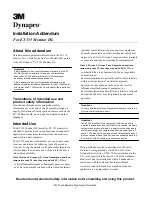
AS
Mxxxx Series User’s Manual
Asia Pacific | EMEA | Americas
62
Select Data Mode:
Select the display parameter against which logged data will be displayed.
Seven display modes are available:
Max/Min Pwr
Max/Min VSWR
Usage
Since the graph is only able to display approximately 200 data points, each of those points may represent multiple captured
level samples. The selection of the Data Mode controls how the multiple samples are combined to present the plotted data
value.
In
Max/Min
mode, only the maximum and minimum sampled values are used, irrespective of when or how often they occurred in
the selected period. If no value reading (above programmed threshold) has been recorded during the period represented by a
data point then a “minimum value” will be displayed on the graph.
In
Usage
mode, the measured occurrence of channel activity (above programmed threshold) during the selected period is
displayed as a percentage. Depending on the number of channels being monitored in each measurement cycle, and the
random sporadic nature of channel activity, this display may some inaccuracy. Practically, it may be used to conveniently
indicate “general” channel (and network) loading, and allows activity to be correlated against specific time/day by viewing the
logged data that has been recorded. This capability is useful for identifying co-incidental channel(s) activity during periods of
interference
– a likely indicator of intermodulation (IM) occurrence.
In
Maximum (1 channel)
mode, only the stored sample with the maximum value during the selected period is used, and;
In
Minimum (1 channel)
mode only the sample with the minimum value is used. If no value reading (above programmed
threshold) has been recorded during the period represented by a data point then a “minimum value” will be displayed on the
graph.
All captured level samples are included in the History File, in CSV format, which may be processed independently (i.e. using
other software) if desired.
Note:
During averaging calculations, the processing of all of the data to create the graph may result in delays to the display
of the data. If a significant amount of data has been logged, displaying periods back in time may also result in delays
while this data is retrieve and then processed.
Display:
This will refresh the display using the selected settings. Some delay may be experienced while data collates.
















































